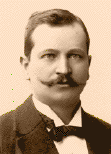| |

Home
Contact Info
Course Info
Calendar
Homework
Lecture Notes
|
|
|
|
PHY 521/321:
Condensed Matter Physics I
Prof. S. Teitel stte@pas.rochester.edu ---- Spring 2010
Problem Set 6
Due Wednesday, April 21, in lecture
- Problem 1
Consider a two dimensional square Bravais lattice with lattice constant a. Suppose the periodic ionic potential is given by,
U(x, y) = -4Ucos(2πx/a)cos(2πy/a)
a) Find the Fourier components UK for reciprocal lattice vectors K.
b) For k = (k, 0) along the kx axis, how does the single electron energy ε(k) behave at the boundary of the first Brillouin Zone, (π/a, 0)?
c) For k = (k, k) along the diagonal of the first Brillouin Zone, how does ε(k) behave at the corner of the first Brillouin Zone, (π/a, π/a)?
- Problem 2 (Ashcroft and Mermin problem 9.3)
Consider the point W, kW = (2π/a)(1, 1/2, 0), in the first Brillouin Zone of an fcc structure (see A&M Fig. 9.14). Here three Bragg planes meet. These Bragg planes bisect the reciprocal lattice vectors K1 = (2π/a)(1,1,1), K2 = (2π/a)(1,1,-1), and K3 = (2π/a)(2,0,0). Hence the free electron states at wavevectors kW, kW − K1, kW − K2, and kW − K3 are degenerate with energies εW0 = (hbar kW)2/2m.
a) Consider the effect of a weak ion potential in splitting these degeneracies. Show that the new energies, to lowest order in the ion potential, are given by the four eigenvalues ε of the matrix:
| εW0 | U1 | U1 | U2 |
| U1 | εW0 | U2 | U1 |
| U1 | U2 | εW0 | U1 |
| U2 | U1 | U1 | εW0 |
where U1 is the Fourier component of the ionic potential at K1 and at K2 (they are equal by cubic symmetry) and U2 is the Fourier component of the ionic potential at K3. Show that these eigenvalues are:
ε= ε0−U2 (twice), and ε=ε0+U2±2U1
b) Using a similar method, show that the energies at the point U (see A&M Fig. 9.14), kU = (2π/a)(1, 1/4, 1/4), are
ε=εU0−U2, ε=εU0+(1/2)U2±(1/2)(U22+8U12)1/2,
where εU0=(hbar kU)2/2m.
- Problem 3
Consider a band with an anisotropic dispersion relation,
| ε(k) = | (hbar)2
2 | ( | kx2
mx | + | ky2
my | + | kz2
mz | ) |
a) Using the fact that an ellipsoid given by the equation, (x/a)2 + (y/b)2 + (z/c)2 = 1, encloses a volume (4π/3)abc, calculate the density of states g(ε). Hint: One can write for the density of states, g(ε)=dG(ε)/dε, where G(ε) is the number of single electron states per unit volume with energy less than ε.
b) We learned that, at sufficiently low temperatures, the contribution to the specific heat at constant volume due to the conduction electrons is given by cv = γ T, where γ is a constant independent of temperature. For the anisotropic band structure considered here, explain why γ is proportional to the effective mass m* = (mxmymz)1/3.
|
|
